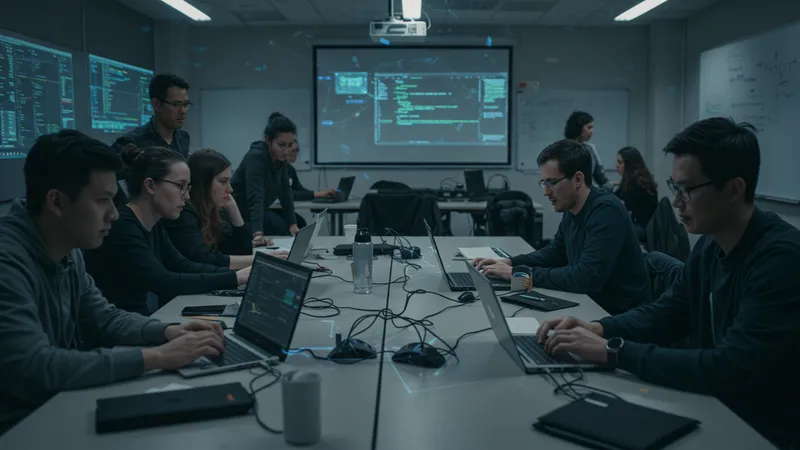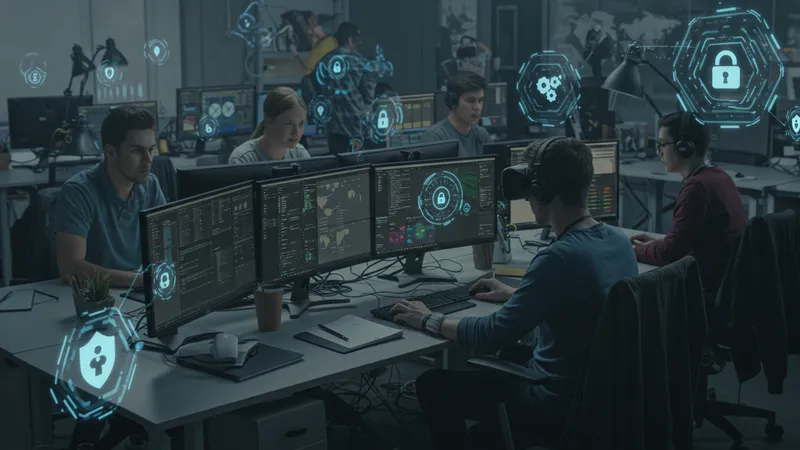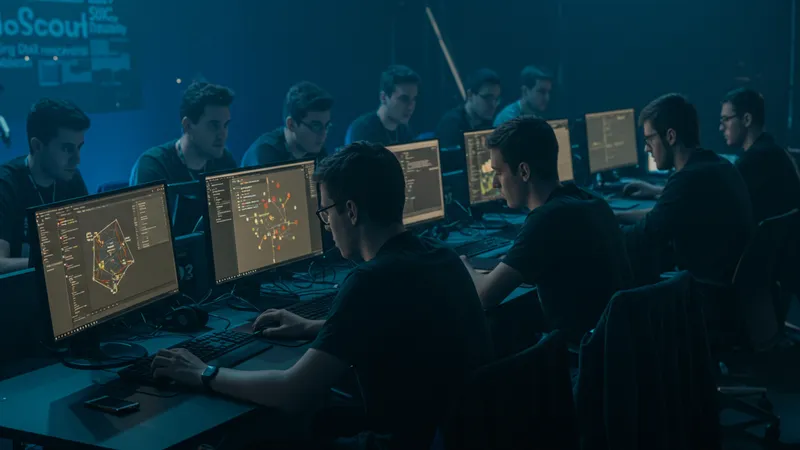

What if I told you there's an education path that promises not only job security but also the thrill of constant mental challenge? Diving into cybersecurity studies might be the answer you never knew you needed. Yet, it involves more than just understanding firewalls.
In a world that's more connected than ever, the gap between educational offerings and real-world needs in cybersecurity is widening alarmingly. Companies are under pressure to secure data, and they need skilled professionals now. But is academia keeping up?

While universities worldwide scramble to adapt their cybersecurity curriculums, many remain focused on outdated concepts that lack the flexibility to tackle modern threats. Alarmingly, only a fraction of graduates feel prepared to handle real cyberattacks. But that’s not even the wildest part…
Industries report an 84% skill gap in cybersecurity roles – a statistic that might shock you. Surprisingly, companies are now looking beyond college degrees, favoring hands-on experience and certifications instead. This trend could redefine how we value formal education versus practical skills. But there’s still more you need to know...
What happens next shocked even the experts in the field. Prepare to uncover the untold truths about cybersecurity education, shedding light on where true value lies. Is traditional study enough, or is there a new path to becoming a cyber guardian extraordinaire? Keep reading to find out.
Many educational institutions are still stuck in the past, with cybersecurity programs that focus heavily on theoretical aspects, ignoring the evolving nature of cyber threats. Students spend countless hours memorizing data encryption techniques that are easily outdated by practical real-world threats. The result is an education that leaves graduates wide-eyed and unprepared when facing dynamic cyber crimes. However, this is just the beginning of a much larger issue...

Shockingly, a significant number of universities lack courses dedicated to mobile security, a glaring omission given our smartphone dependency. Mobile devices are among the most targeted by hackers, yet they remain an underexplored subject in most curriculums. This lack of education leaves a gaping hole in preparedness. But there’s one more twist to this narrative...
Educators are increasingly pressured to update their materials, yet budget constraints and administrative red tape impede progress. The struggle to keep up with fast-paced innovations results in an education that moves at a snail's pace. This disconnect between evolving threats and static curricula is a ticking time bomb. What you read next might change how you see this forever...
The push for universities to integrate real-world practice through partnerships with tech companies is a rising trend. Some institutions are beginning to offer hands-on labs and internships as a bridge between theory and practice. These forward-thinking strategies are slowly being embraced, hinting at a brighter future. However, the challenge remains enormous. Could this be the key to solving the professional competency crisis in cybersecurity?
In the relentless march towards a digital future, certifications in cybersecurity are quickly emerging as the golden ticket to employment. Unlike traditional degrees that often take years to complete, certifications like CompTIA Security+ and Certified Ethical Hacker (CEH) are being recognized for their rigorous, targeted training. Such certifications often cover current and emerging cybersecurity practices ignored by many degree programs, offering fast-tracked pathways to expertise. But this is just scratching the surface...

Companies are seeking professionals who can hit the ground running, and certified individuals often bring immediately applicable skills to the table. With the digital world evolving at breakneck speed, the demand for certified experts has surged. Certifications now eclipse degrees in hiring decisions, marking a significant shift in industry expectations. The story doesn’t end here though...
Furthermore, certifications provide a way for professionals to demonstrate their ability to stay updated with cutting-edge skills in a field that transforms rapidly. As cyber threats evolve, so do the certification requirements, ensuring that holders possess up-to-date knowledge and methodologies. But there’s a minor detail that’s often overlooked...
Despite their growing importance, obtaining certifications can be a costly endeavor, with exams ranging from a few hundred to thousands of dollars. However, many leading tech companies are starting to sponsor or reimburse these certifications for their employees, acknowledging their critical importance in the sphere of cybersecurity. Is this the new wave of education and professional development?
Bootcamps have exploded onto the scene as a solution for those looking to quickly pivot into cybersecurity careers. These intensive training programs promise to arm students with essential skills in weeks rather than years, a stark contrast to traditional education paths. Bootcamps focus primarily on hands-on experiences and project-based learning, often skipping theoretical components for practical application. But wait, there's more to this story than meets the eye...

Despite their short duration, bootcamps can be expensive, sometimes exceeding the cost of a semester at a university. Yet, participants often regard them as invaluable investments due to their focused nature and immediate job placement opportunities. For many, bootcamps provide a fast-track to a thriving career in cybersecurity. But not everything is as flawless as it seems...
Critics argue that while bootcamps are effective for immediate job readiness, they might not fully prepare students for long-term innovation and leadership roles without the broader foundational knowledge provided by degree programs. This points to an ongoing debate about depth versus applicability in education. Still, some believe there's a middle ground yet to be explored...
An emerging trend sees some universities collaborating with bootcamps to offer hybrid programs, merging in-depth academic theory with rapid, practical bootcamp experiences. This novel approach could possibly redefine the educational landscape, offering the best of both worlds. Are hybrid programs the future of education in the digital age?
Governments around the world recognize the vital importance of bolstering cybersecurity defenses, prompting initiatives designed to enhance training and education in this field. The introduction of government-backed courses and scholarships for aspiring cybersecurity professionals is a significant move. These initiatives aim to boost interest and competence in the field, directly addressing the skill gap that plagues industries worldwide. But are these efforts producing tangible results?

Particularly notable is the rise of public-private partnerships which allow students access to up-to-date technology and practical training. Such collaborations offer resources that would typically be unavailable in conventional academic settings. The engagement between governmental bodies and the tech industry could be the push needed to keep educational programs fresh and relevant. But this isn’t the entire picture...
Despite these efforts, some criticize government programs for being slow to adapt to the rapidly changing nature of cybersecurity threats. Bureaucratic barriers often delay the introduction of innovative training methods. Consequently, graduates are occasionally equipped with outmoded skills, ill-prepared for an agile industry. However, there's more on the horizon driving change...
In recent strides, governments are beginning to adopt a more dynamic approach by integrating real-time threat scenarios into educational curriculums. This shift from static learning to active simulation allows students to gain unparalleled insights and hands-on experience. As these programs continue to evolve, the landscape of cybersecurity education might transform exponentially. Are we on the brink of a new era in cybersecurity learning?
As the threat landscape diversifies, educators face the growing challenge of staying ahead. Crafting curriculums that accurately reflect real-world threats requires not only the right content but continuous updates to keep pace with hackers’ ever-evolving tactics. With technology altering so rapidly, universities are hard-pressed to maintain programs that resonate with the industry’s cutting-edge demands. However, this is just the beginning of their struggle...

Resource limitations and limited access to up-to-date hardware and software often handicap educational institutions. This leaves students equipped with theoretical knowledge but lacking the necessary practical experience in dealing with modern cyber threats. But there’s an unexpected twist to this predicament...
Increasingly, some institutions are turning to online platforms to fill the void. Advanced simulations, conducted remotely, have become a key strategy in enhancing student readiness. Despite logistical issues and the lack of physical engagement, these virtual approaches offer a bridge to otherwise inaccessible real-world scenarios. But the story doesn’t end here...
The innovative use of gamification in educational settings is also being explored. By incorporating elements of competition and reward, students can engage in cybersecurity exercises in a more dynamic and intriguing manner. This game-like structure encourages excitement and motivation to tackle complex cybersecurity challenges. Could this playful approach be the much-needed catalyst in re-energizing cybersecurity education?
In recent years, hackathons have emerged as a powerful educational tool within the cybersecurity space. These marathon coding events provide students with the rare opportunity to tackle real-world security challenges within condensed timeframes, promoting creativity and innovation. Often held through partnerships with tech giants, hackathons simulate pressure-cooker environments that prepare students for fast-paced, high-stakes situations. But what deeper secrets do these events hold?
Beyond fostering technical skills, hackathons champion teamwork and collaboration, key competencies in cybersecurity. The collaborative efforts required to untangle complex, layered problems mimic the real-world scenarios professionals regularly face. The results often speak for themselves; many companies now recognize hackathons as integral to uncovering hidden talent. But there’s more to this high-octane approach...
Despite their many advantages, hackathons are not without criticism. The intense nature of these sprints can sometimes undervalue individual contributions, instead rewarding speed over thoughtful strategy and depth. Additionally, participants often experience burnout, raising questions about their sustainability. Still, there’s an evolution on the horizon...
Addressing these drawbacks, hybrid events that combine hackathons with longer-term projects are emerging. By blending the immediate adrenaline rush of a hackathon with ongoing team-based projects, participants gain both the necessary technical skills and the endurance required for long-term success in the industry. Can these innovations redefine how we incubate future cybersecurity talents?
In an industry as dynamic as cybersecurity, diverse perspectives can be the key to innovative solutions. Surprisingly, many successful professionals have entered the field from non-technical backgrounds such as psychology, linguistics, or even arts. These unique lenses provide fresh approaches to problem-solving, challenging the traditional pathways to entering the industry. But this unconventional entry has a much deeper implication...

Employing individuals from varied educational backgrounds enriches a team’s ability to tackle complex problems in creative ways. Different experiences and skill sets foster innovative thinking, enabling teams to find novel solutions to persistent cybersecurity issues. Consequently, companies are beginning to broaden their hiring criteria. But what lies beneath this expanding trend?
While technical skills are undeniably important, soft skills like communication, adaptability, and critical thinking are increasingly valued. Individuals from diverse fields often possess these skills in abundance, allowing them to bridge gaps and facilitate better teamwork within cybersecurity frameworks. This holistic approach to hiring might just reshape the industry. However, there are obstacles to overcome...
Integrating these diverse talents requires companies to redefine their onboarding and training processes, ensuring that non-traditional hires have opportunities to build essential technical competencies. As these inclusive strategies gain traction, the cybersecurity industry could witness a paradigm shift, embracing varied backgrounds as a foundation for its future growth. Is this the dawn of a more inclusive cybersecurity field?
Despite the digital revolution, one of the longstanding challenges in cybersecurity remains the pronounced gender gap. Women, significantly underrepresented, make up only about 20% of the cybersecurity workforce. This startling disparity highlights an untapped potential in addressing the escalating demand for skilled professionals. But it's not just a numbers game...

Integrating more women into cybersecurity is not merely a pursuit of equality; it enriches teams with different perspectives that promote creativity and innovation. Numerous studies consistently underscore how diverse teams outperform their homogenous counterparts in problem-solving and innovation. Yet, the journey to gender parity presents its own set of challenges...
Many women encounter psychological and cultural barriers that deter them from entering or advancing in cyber fields. Stereotypes regarding technical prowess or a lack of role models can discourage prospective female talent. Nevertheless, there are rays of hope as change takes root...
Organizations and educational entities are implementing initiatives to support women in cybersecurity, offering mentorship programs, scholarships, and networks that empower them to navigate and thrive in the industry. Efforts to highlight female role models and champions are crucial steps towards breaking down these barriers. Can these initiatives pave the way for a balanced cybersecurity workforce?
Artificial Intelligence (AI) is revolutionizing every sector, and cybersecurity is no exception. Its integration into cybersecurity education is transforming how both students and professionals perceive threat detection and response. AI is used to identify and mitigate sophisticated attacks faster than any human expert could manage. But does it also change the face of learning?

AI-driven simulations provide an enriched training experience with personalized curricula that evolve based on individual progress. This adaptive learning empowers students to hone their strengths while addressing weaknesses in an interactive, engaging manner. As AI technologies advance, they promise ever-greater enhancements to educational outcomes. Still, there’s a complication that needs addressing...
Despite its benefits, incorporating AI into learning comes with significant challenges. Concerns about data privacy and the ethics of AI applications in education present persistent hurdles. Additionally, the reliance on technology could lead to an over-dependence that undercuts critical thinking skills. But there's another dimension to consider...
The potential for AI to democratize education is profound, breaking down geographical and economic barriers that traditionally limit access to high-quality learning. As AI continues to permeate the educational landscape, it is poised to afford previously unimaginable opportunities. Could this gradual revolution rectify inequalities and foster a global renaissance in cybersecurity education?
Beyond the confines of conventional classrooms, internships offer an indispensable introduction to the vast world of cybersecurity. These hands-on experiences act as a crucial bridge, propelling students from theoretical study into practical application. Internships immerse students in real-world environments, enabling them to grasp the nuances of cybersecurity tasks. But is that all?

For many graduates, internships provide a foothold into the industry, opening doors to future employment opportunities. Employers frequently scout their internship programs for top talent to bring on board long-term. But there’s a catch—while beneficial, the quality and relevance of internships can vary drastically, making it a gamble for students. What else is unfolding in this underexplored area?
Some progressive companies are beginning to refine their internship programs to focus more on mentorship and professional growth. By enriching the learning experience, firms not only get value from the fresh perspectives of interns but also develop future leaders for their organization. But there’s more to consider...
The rise of virtual internships is another trend reshaping cybersecurity education. As remote work becomes a staple, virtual internships are offering students global opportunities they couldn't otherwise access. Though they come with challenges in training and communication, these programs empower students with a breadth of international perspectives and experiences. Is this the next step in redefining internship experiences across industries?
Cybersecurity is not just attracting fresh graduates; it’s also a beacon for mid-career professionals eyeing a shift. Individuals from sectors as diverse as finance, law, and healthcare are transitioning into cybersecurity roles, enticed by the sector’s promising growth and impact. But what drives this significant shift?

For many, their previous experience lends them a unique advantage, forming a cross-disciplinary bridge within the cybersecurity realm. Skills cultivated in other industries, such as analytical thinking, legal expertise, or data management, find immediate resonance in cybersecurity contexts. This synergy often makes for a seamless transition, but there are hurdles...
The journey into cybersecurity isn’t without its challenges. Many mid-career professionals confront steep learning curves, grappling with new technologies and environments. Fortunately, targeted training and adaptive programs are emerging to smooth this transition, offering pathways tailored for such career pivots. But there’s a broader implication...
As professionals wade into cybersecurity with diverse backgrounds, they transform the workspace, nurturing a holistic environment conducive to innovation. The blend of traditional knowledge with fresh insights is invaluable in foreseeing and addressing cybersecurity challenges comprehensively. Is this multi-dimensional workforce the future of cybersecurity success?
Forgotten in the excitement of formal education is the power of competitions. Cybersecurity competitions serve as fertile training grounds, offering students and enthusiasts alike a chance to pit their skills against others in interactive, investigative settings. By replicating real-world scenarios, these competitions offer more than just trophies. What lies beneath this competitive spirit?

They cultivate a problem-solving mindset, focusing on critical thinking and quick decision-making. Participants are faced with security puzzles that push them to apply learned concepts practically, often learning valuable lessons in the process. But the influence extends beyond personal education...
Cybersecurity competitions are community builders. They provide a nexus for like-minded individuals to connect, share knowledge, and foster future collaborations. This sense of community is crucial for personal growth, networking, and exploring diverse perspectives within the field. You might wonder, is this all about games?
The competitive yet collaborative dynamic prepares participants for the high-pressure environments they will likely encounter professionally. The value of cybersecurity competitions lies in balancing healthy rivalry with team engagement, where the aggregation of ideas leads to progress. Are these competitions a vital piece in the cybersecurity education puzzle?
Apprenticeships have long been a staple across trades, but in the realm of cybersecurity, they’re a budding concept. Straddling the line between education and employment, apprenticeships deliver intensely practical experience. Within these frameworks, budding cybersecurity professionals work alongside mentors, traversing the learning curve under guided expertise. But what sets this pathway apart?

Apprenticeships offer unique benefits by immersively combining hands-on work with academic learning. They provide an in-depth view of real-world operations that textbooks can't capture, establishing a bedrock for well-rounded knowledge. The mentorship aspect further enriches this learning journey, but there are limitations...
Assessing the competency and readiness of apprentices can be tricky, given their role as perpetual learners and workers. Balancing work responsibilities with the demands of learning can be challenging, making the structuring of apprenticeship programs crucial. However, there’s a twist in this tale...
Some industries are co-developing apprenticeships with educational institutions, infusing flexibility and tailored curricula into the mix. This aligns academic theory closely with practical realities, marrying two outcomes often considered dichotomous. Could apprenticeship become the standard across cybersecurity training?
As cybersecurity threats continue to mutate, so too must the education approaches that generate the defenders of the future. The fusion of traditional education with innovative methodologies like personalized learning, practical experiences, and unconventional pathways is blurring the once clear-cut boundaries of academic and professional development. But isn't there something more profound at play?

In this evolving landscape, the focus is shifting from rote learning to adaptive, interdisciplinary strategies that also address emerging risks and technological changes. This constantly updated, hands-on approach encourages a cycle of continuous learning, essential in a field where yesterday’s knowledge can swiftly become obsolete. What broader implications could this have?
The global nature of cyber threats necessitates a broadening of educational programs to incorporate international perspectives and cooperation. Collaborative efforts between countries and institutions are vital in creating robust cybersecurity protocols and cultivating shared knowledge about potential threats. But there’s a horizon yet unexplored...
The interplay between educators, industry leaders, and governmental bodies in forging a versatile, future-ready path for cybersecurity education could potentially redefine global defenses. Prioritizing a sustainable and dynamic learning environment might hold the key to leading the fight against cybercrime effectively. Could this holistic approach be the cornerstone of cybersecurity's evolving narrative?
The future of cybersecurity education rests on the cusp of change, orchestrated by the requirement for simultaneous innovation and adaptability. As boundaries blur and new pathways emerge, one lesson stands out with clarity: adaptability is king. Embracing alternative education models, incorporating real-time learning experiences, and valuing non-traditional career backgrounds could engineer an era of unprecedented cybersecurity readiness. So, what step will you take next in this pivotal journey? Discover, share, and join the frontline of a digitally secure world now.